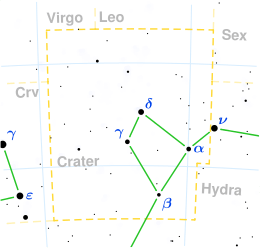Gamma Crateris
Gamma Crateris is a binary star[7] system, divisible with a small amateur telescope,[14] and located at the center of the southern constellation of Crater. It is visible to the naked eye with an apparent visual magnitude of 4.06.[2] With an annual parallax shift of 39.62 mas as seen from Earth, this star is located 82.3 light years from the Sun. Based upon the motion of this system through space, it is a potential member of the Castor Moving Group.[15]
 | |
| Observation data Epoch J2000.0 Equinox J2000.0 (ICRS) | |
|---|---|
| Constellation | Crater |
| Right ascension | 11h 24m 52.92362s[1] |
| Declination | −17° 41′ 02.4300″[1] |
| Apparent magnitude (V) | 4.06[2] |
| Characteristics | |
| Spectral type | A9 V[3] |
| U−B color index | +0.09[2] |
| B−V color index | +0.22[2] |
| Astrometry | |
| Radial velocity (Rv) | +1.0±4.1[4] km/s |
| Proper motion (μ) | RA: −97.42[1] mas/yr Dec.: +3.65[1] mas/yr |
| Parallax (π) | 38.0906 ± 0.3570[5] mas |
| Distance | 85.6 ± 0.8 ly (26.3 ± 0.2 pc) |
| Absolute magnitude (MV) | +2.05[6] |
| Details | |
| γ Crt A | |
| Mass | 1.81[7] M☉ |
| Radius | 1.3[8] R☉ |
| Luminosity | 18.8[9] L☉ |
| Surface gravity (log g) | 4.21±0.14[10] cgs |
| Temperature | 8,020±273[10] K |
| Metallicity [Fe/H] | −0.01[11] dex |
| Rotational velocity (v sin i) | 144[12] km/s |
| Age | 757[10] Myr |
| γ Crt B | |
| Mass | 0.75[7] M☉ |
| Other designations | |
| Database references | |
| SIMBAD | data |
The primary, component A, is a white-hued A-type main sequence star of apparent visual magnitude 4.08 with a stellar classification of A9 V.[3] The star has an estimated 1.81[7] times the mass of the Sun and around 1.3[8] times the Sun's radius. It is about 757[10] million years old and is spinning with a projected rotational velocity of 144 km/s.[12] The primary is radiating 18.8[9] times the solar luminosity from its outer atmosphere at an effective temperature of 8,020 K.[10] Based upon the detection of an infrared excess, the star may host an orbiting debris disk.[9] However, this finding remains in doubt.[16]
The companion, component B, is a magnitude 9.6 star with an estimated mass 75% that of the Sun. As of 2010, the companion was located at an angular separation of 4.98 arc seconds along a position angle of 93.1° relative to the primary. This is equivalent to a projected separation of 125.6 AU.[7] This star may be the source of the X-ray emission detected coming from this system.[17]
References
- van Leeuwen, F. (2007), "Validation of the new Hipparcos reduction", Astronomy and Astrophysics, 474 (2): 653–664, arXiv:0708.1752, Bibcode:2007A&A...474..653V, doi:10.1051/0004-6361:20078357.
- Mermilliod, J.-C. (1986), "Compilation of Eggen's UBV data, transformed to UBV (unpublished)", Catalogue of Eggen's UBV Data, SIMBAD, Bibcode:1986EgUBV........0M.
- Houk, Nancy; Smith-Moore, M. (1978), Michigan catalogue of two-dimensional spectral types for the HD stars, 4, Ann Arbor: Dept. of Astronomy, University of Michigan, Bibcode:1988mcts.book.....H.
- de Bruijne, J. H. J.; Eilers, A.-C. (October 2012), "Radial velocities for the HIPPARCOS-Gaia Hundred-Thousand-Proper-Motion project", Astronomy & Astrophysics, 546: 14, arXiv:1208.3048, Bibcode:2012A&A...546A..61D, doi:10.1051/0004-6361/201219219, A61.
- Brown, A. G. A.; et al. (Gaia collaboration) (August 2018). "Gaia Data Release 2: Summary of the contents and survey properties". Astronomy & Astrophysics. 616. A1. arXiv:1804.09365. Bibcode:2018A&A...616A...1G. doi:10.1051/0004-6361/201833051. Gaia DR2 record for this source at VizieR.
- Anderson, E.; Francis, Ch. (2012), "XHIP: An extended hipparcos compilation", Astronomy Letters, 38 (5): 331, arXiv:1108.4971, Bibcode:2012AstL...38..331A, doi:10.1134/S1063773712050015.
- De Rosa, R. J.; et al. (2013), "The VAST Survey - III. The multiplicity of A-type stars within 75 pc", Monthly Notices of the Royal Astronomical Society, 437 (2): 1216, arXiv:1311.7141, Bibcode:2014MNRAS.437.1216D, doi:10.1093/mnras/stt1932.
- Pasinetti Fracassini, L. E.; et al. (February 2001), "Catalogue of Apparent Diameters and Absolute Radii of Stars (CADARS)", Astronomy and Astrophysics (3rd ed.), 367: 521–524, arXiv:astro-ph/0012289, Bibcode:2001A&A...367..521P, doi:10.1051/0004-6361:20000451.
- Hales, Antonio S.; et al. (April 2017), "Atomic gas in debris discs", Monthly Notices of the Royal Astronomical Society, 466 (3): 3582–3593, arXiv:1612.05465, Bibcode:2017MNRAS.466.3582H, doi:10.1093/mnras/stw3274.
- David, Trevor J.; Hillenbrand, Lynne A. (2015), "The Ages of Early-Type Stars: Strömgren Photometric Methods Calibrated, Validated, Tested, and Applied to Hosts and Prospective Hosts of Directly Imaged Exoplanets", The Astrophysical Journal, 804 (2): 146, arXiv:1501.03154, Bibcode:2015ApJ...804..146D, doi:10.1088/0004-637X/804/2/146.
- Saffe, C.; Gómez, M.; Pintado, O.; González, E. (October 2008), "Spectroscopic metallicities of Vega-like stars", Astronomy and Astrophysics, 490 (1): 297–305, arXiv:0805.3936, Bibcode:2008A&A...490..297S, doi:10.1051/0004-6361:200810260.
- Royer, F.; et al. (February 2007), "Rotational velocities of A-type stars. III. Velocity distributions", Astronomy and Astrophysics, 463 (2): 671–682, arXiv:astro-ph/0610785, Bibcode:2007A&A...463..671R, doi:10.1051/0004-6361:20065224.
- "gam Crt". SIMBAD. Centre de données astronomiques de Strasbourg. Retrieved 2017-03-02.
- Monks, Neale (2010), Go-To Telescopes Under Suburban Skies, The Patrick Moore Practical Astronomy Series, Springer Science & Business Media, p. 113, ISBN 1441968512.
- Nakajima, Tadashi; et al. (September 2010), "Potential Members of Stellar Kinematical Groups within 20 pc of the Sun", The Astronomical Journal, 140 (3): 713–722, Bibcode:2010AJ....140..713N, doi:10.1088/0004-6256/140/3/713.
- Ertel, S.; et al. (October 2014), "A near-infrared interferometric survey of debris-disk stars. IV. An unbiased sample of 92 southern stars observed in H band with VLTI/PIONIER", Astronomy & Astrophysics, 570: 20, arXiv:1409.6143, Bibcode:2014A&A...570A.128E, doi:10.1051/0004-6361/201424438, A128.
- Schröder, C.; Schmitt, J. H. M. M. (November 2007), "X-ray emission from A-type stars", Astronomy and Astrophysics, 475 (2): 677–684, Bibcode:2007A&A...475..677S, doi:10.1051/0004-6361:20077429.
External links
- Kaler, James B. (April 15, 2011), "Gamma Crateris", Stars, University of Illinois, retrieved 2017-03-03.